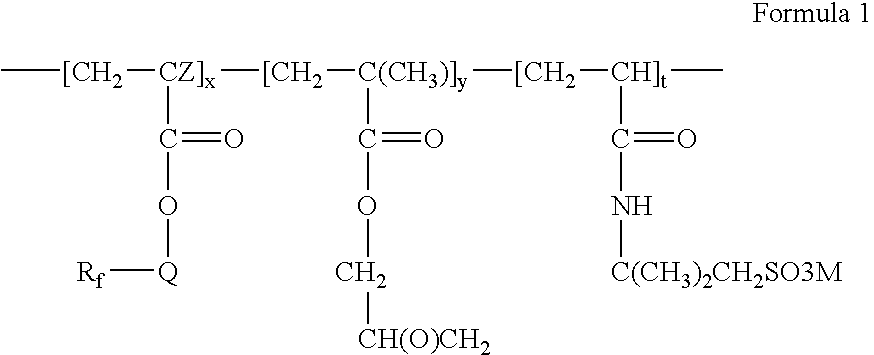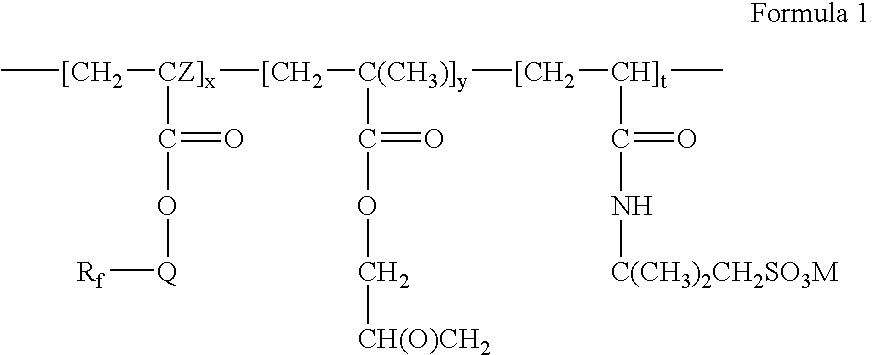Fluorinated water soluble copolymers
a technology of methacrylate and fluoroalkyl group, which is applied in the direction of synthetic resin layered products, detergent compounding agents, weaving, etc., can solve the problems that short fluoroalkyl group having 6 or less carbons has traditionally not been successful commercially in imparting and no surface effects to substrates are disclosed
- Summary
- Abstract
- Description
- Claims
- Application Information
AI Technical Summary
Benefits of technology
Problems solved by technology
Method used
Image
Examples
example 1
[0124]In Example 1, a copolymer was prepared as described below. In a four-neck 500 mL round bottom flask fitted with a condenser, mechanical stirrer, gas inlet, and gas outlet was added 1H,1H,2H,2H-perfluorooctylmethacrylate ester (7.0 grams, 0.016 moles), 1H,1H,2H,2H-perfluorooctylacrylate ester (3.0 grams, 0.0072 moles), 2-acrylamido-2-methyl-1-propanesulfonic acid (AMPS, 2.5 grams, 0.012 moles), glycidyl (meth)acrylate (GMA, 0.2 grams, 0.0014 moles), dodecyl mercaptan (0.04 grams), VAZO 67 (1.32 grams), and 2-propanol (200 grams). While stirring at 150 rpm at 20° C. for one hour, dry nitrogen was gently bubbled through the solution to remove any oxygen. The nitrogen bubbling was replaced with a blanket of nitrogen and the reaction mixture was heated to 80° C. with stirring for 16 hours. The nitrogen blanket was removed and the polymer solution was allowed to cool to 20° C. Approximately 150 grams of the 2-propanol was removed by reduced temperature distillation. A solution of so...
examples 2-18
[0125]In Examples 2-18, the copolymer compounds listed in Table 3 were prepared using the procedure described above in Example 1.
TABLE 3Copolymer CompoundsMonomer A (%Monomer BGMA*AMPS*Copolymerweight)(% weight)(% weight)(% weight)Example 123.6%55.1%1.6%19.7%Example 2 7.9%70.9%1.5%19.7%Example 3 6.8%61.3%2.7%29.2%Example 4 7.7%69.8%3.1%19.4%Example 520.4%47.7%2.7%29.2%Example 620.7%48.3%1.4%29.6%Example 7 0%75.8%1.5%22.7%Example 8 0%78.7%1.6%19.7%Example 9 0%73.0%1.5%25.5%Example 1023.5%54.9%1.6%19.6%Example 1115.7%62.7%1.6%19.6%Example 1211.0%62.3%1.6%24.9%Example 1320.7%48.3%1.4%29.6%Example 1418.5%43.2%1.2%37.0%Example 1514.9%34.6%0.1%49.5%Example 16 5.0%44.6%1.6%49.5%Example 1714.9%34.6%0.0%49.5%Example 1812.9%30.2%0.9%56.0%*GMA is glycidyl(meth)acrylate*AMPS is 2-acryloamido-2methyl-1-propanesulfonic acid
[0126]The copolymer solutions prepared above from Examples 2-18 were applied using Test Method 1 to 100% cotton fabrics. The treated fabrics were tested for wicking, and hyd...
examples 19-26
[0130]In Examples 19-26 the copolymer compounds listed in Table 6 were prepared using the procedure described above in Example 1.
TABLE 6Copolymer CompoundsGMA*AMPS*CopolymerMonomer(% by(% byCompound(% by weight)weight)weight)Example 19F—(CF2CF2CH2CH2)nO—COCH═CH21.4%29.6%(69.0%)Example 20(C3F7OCF(CF3)CONHCH2)2CHO—COCH═CH21.4%29.6%(69.0%)Example 21C3F7OCF(CF3)CONHCH2CH2O—COCH═CH21.4%29.6%(69.0%)Example 22C4F9CH2CF2CH2CH2O—COCH═CH21.4%29.6%(69.0%)Example 23C4F9CH2CF2CH2CH2O—COC(CH3)═CH21.4%29.6%(69.0%)Example 24C3F7OCF2CF2CH2CH2O—COCH═CH21.4%29.6%(69.0%)Example 25C3F7OCF2CF2CH2CH2O—COC(CH3)═CH21.4%29.6%(69.0%)Example 26C4F9CH2CH2OCONHCH2CH2O—COC(CH3)═CH21.4%29.6%(69.0%)*GMA is glycidyl(meth)acrylate*AMPS is 2-acryloamido-2methyl-1-propanesulfonic acid
[0131]The copolymer solutions prepared from Examples 19-26 above were applied using Test Method 1 to 100% cotton fabrics. The treated fabrics were tested for wicking, and hydrophilic stain release using Test Method 1. The results are liste...
PUM
| Property | Measurement | Unit |
|---|---|---|
| Fraction | aaaaa | aaaaa |
| Fraction | aaaaa | aaaaa |
| Percent by mass | aaaaa | aaaaa |
Abstract
- Rf is a straight or branched perfluoroalkyl group having from about 2 to about 8 carbon atoms, or a mixture thereof, which is optionally interrupted by at least one oxygen atom,
- Q is alkylene of 1 to about 15 carbon atoms, hydroxyalkylene of 2 to about 15 carbon atoms, —O(CnH2n)—, —(CH2CF2)m(CH2)n—, —CONR1(CnH2n)—, —(CnH2n)OCONR1(CnH2n)—, (—CONR1CH2)2CH—, —SO2N(R1)(CnH2n)—, or —(CnH2n)SO2N(R1)(CnH2n)—,
- each R1 is independently H or alkyl of 1 to about 4 carbon atoms,
- each n is independently 1 to about 15,
- each m is independently 1 to about 4,
- Z is hydrogen or methyl,
- x is a positive integer,
- y is zero or a positive integer,
- t is a positive integer, and
- M is H+, alkali metal cation, alkaline earth metal cation, or ammonium.
Description
Claims
Application Information
 Login to View More
Login to View More - R&D
- Intellectual Property
- Life Sciences
- Materials
- Tech Scout
- Unparalleled Data Quality
- Higher Quality Content
- 60% Fewer Hallucinations
Browse by: Latest US Patents, China's latest patents, Technical Efficacy Thesaurus, Application Domain, Technology Topic, Popular Technical Reports.
© 2025 PatSnap. All rights reserved.Legal|Privacy policy|Modern Slavery Act Transparency Statement|Sitemap|About US| Contact US: help@patsnap.com



